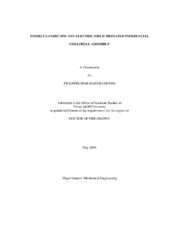| dc.description.abstract | Chemically and physically patterned surfaces can be used as templates to guide
nano- and micro- scale particle assembly, but the design is often limited by an inability
to sufficiently characterize how pattern features influence local particle-surface
interactions on the order of thermal energy, kT. The research outlined in this dissertation
describes comprehensive optical microscopy (i.e. evanescent wave, video)
measurements and analyses of many-body and multi-dimensional interactions, dynamics
and structure in inhomogeneous colloidal fluid systems. In particular, I demonstrate
how non-intrusive observation of an ensemble of particles diffusing past each other and
over a physically patterned surface topography can be used to obtain sensitive images of
energy landscape features. I also link diffusing colloidal probe dynamics to energy
landscape features, which is important for understanding the temporal imaging process
and self-assembly kinetics. A complementary effort in this dissertation investigated the
use of external AC electric fields to reversibly tune colloidal interactions to produce
metastable ordered configurations. In addition, the electrical impedance spectra associated with colloidal assemblies formed between interfacial microelectrode gaps was
measured and consistently modelled using representative equivalent circuits.
Significant results from this dissertation include the synergistic use of the very
same colloids as both imaging probes and building blocks in feedback controlled selfassembly
on patterns. Cycling the AC field frequencies was found to be an effective
way to anneal equilibrium colloidal configurations. Quantitative predictions of
dominant transport mechanisms as a function of AC electric field amplitude and
frequency were able to consistently explain the steady-state colloidal microstructures
formed within electrode gaps observed using video microscopy. A functional electrical
switch using gold nanoparticles was realized by reversibly forming and breaking
colloidal wires between electrode gaps. Extension of the concepts developed in this
dissertation suggest a general strategy to engineer the assembly of colloidal particles into
ordered materials and controllable devices that provide the basis for numerous
emerging technologies (e.g. photonic crystals, nanowires, reconfigurable antennas,
biomimetic materials). | en |


